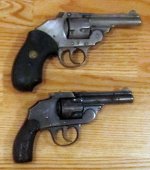Tom-Fairfax
New member
I hope this is the right forum because I have one final question about whether the 9MM Federal Rimmed cartridge is interchangeable with the .38 S&W. I'm asking because the 9MM Federal Rimmed is out of production. Since I own two Charter Arms Pit Bull revolvers that are chambered for 9MM Federal Rimmed, I need to see if the .38 S&W will substitute as ammunition. The specs for both cartridges are as follows:
9 mm Federal (9x19 mm)
Type: Rimmed
Bullet Diameter .355 in (9.0 mm)
Case length: . .754 in (19.2 mm)
Rim Diameter: .435
Neck Diameter: .382
Base Diameter: .386
Cartridge length: 1.163 in (29.5 mm)
.38 S&W
Type: Rimmed
Bullet Diameter: .359 in (9.1 mm)
Case length: .780 in. (19.8 mm)
Rim Diameter: .433
Neck Diameter: .386
Base Diameter: .386
Cartridge length: 1.200 in (30.5 mm)
The cartridges look similar enough so that I wonder if I can use the .38 SW straight out of the box. The Pit Bull cylinder is deep enough to chamber it. However, all of the reloading information I've read suggests that the proper way to approach this is to cut the .38 S&W case length (.780) down to the length of the 9MM Federal case (.754). Since I clearly don't know anything about this issue, I'd appreciate your assistance in sorting it out. Thanks.
9 mm Federal (9x19 mm)
Type: Rimmed
Bullet Diameter .355 in (9.0 mm)
Case length: . .754 in (19.2 mm)
Rim Diameter: .435
Neck Diameter: .382
Base Diameter: .386
Cartridge length: 1.163 in (29.5 mm)
.38 S&W
Type: Rimmed
Bullet Diameter: .359 in (9.1 mm)
Case length: .780 in. (19.8 mm)
Rim Diameter: .433
Neck Diameter: .386
Base Diameter: .386
Cartridge length: 1.200 in (30.5 mm)
The cartridges look similar enough so that I wonder if I can use the .38 SW straight out of the box. The Pit Bull cylinder is deep enough to chamber it. However, all of the reloading information I've read suggests that the proper way to approach this is to cut the .38 S&W case length (.780) down to the length of the 9MM Federal case (.754). Since I clearly don't know anything about this issue, I'd appreciate your assistance in sorting it out. Thanks.

